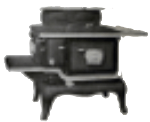Methodology
This project began with an interest in the gendered nature of stove advertisements around the mid-twentieth century. In researching the history of stoves and gender, an important book has been More Work For Mother: The Ironies Of Household Technology From The Open Hearth To The Microwave by Ruth Schwartz Cowan. In her work she talks about the ways in which the stoves design has been improved upon solely for the benefit of men. For example, one significant development was the ability to use things like gas or electricity to cook. The one who innately benefits from this change, as Cowan argues, is men for they no longer must chop enough firewood to keep a stove going. Using this as a starting point of inquiry, I began looking into how this translates into the development of stoves in the first half of the twentieth century and their advertisement in connection to gender.
In creating this project, I have cultivated a largely digital source base or have used technology to find the relevant physical sources. Using databases for my secondary sources like Omni, University of Ottawa’s library database, I was able to get not just digital articles but also physical books that have proved invaluable especially in covering the topics of gender and domestic work. In terms of primary sources, I have largely used the online collection of mail-order catalogues from Library and Archives Canada. However, I have added individual advertisements posted by local groups of stove advertisements related to their communities and included photographs and flipbooks of physical documents from Ingenium’s trade literature collection.
What led to this exhibit's creation is the ability to present it in a more accessible format with more interactive visuals in comparison to a traditional paper. As someone interested in the information field, I appreciate the ability to lay out as much information about the primary sources that I am using for an audience. This format also afforded me a space to practice coding, and even though I ended up using only small aspects in the final product it gave me the chance to test out different inputs.
